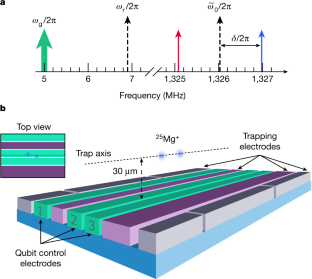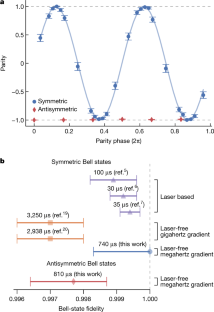Abstract
Universal control of multiple qubits—the ability to entangle qubits and to perform arbitrary individual qubit operations1—is a fundamental resource for quantum computing2, simulation3 and networking4. Qubits realized in trapped atomic ions have shown the highest-fidelity two-qubit entangling operations5,6,7 and single-qubit rotations8 so far. Universal control of trapped ion qubits has been separately demonstrated using tightly focused laser beams9,10,11,12 or by moving ions with respect to laser beams13,14,15, but at lower fidelities. Laser-free entangling methods16,17,18,19,20 may offer improved scalability by harnessing microwave technology developed for wireless communications, but so far their performance has lagged the best reported laser-based approaches. Here we demonstrate high-fidelity laser-free universal control of two trapped-ion qubits by creating both symmetric and antisymmetric maximally entangled states with fidelities of \({1}_{-0.0017}^{+0}\) and \({0.9977}_{-0.0013}^{+0.0010}\), respectively (68 per cent confidence level), corrected for initialization error. We use a scheme based on radiofrequency magnetic field gradients combined with microwave magnetic fields that is robust against multiple sources of decoherence and usable with essentially any trapped ion species. The scheme has the potential to perform simultaneous entangling operations on multiple pairs of ions in a large-scale trapped-ion quantum processor without increasing control signal power or complexity. Combining this technology with low-power laser light delivered via trap-integrated photonics21,22 and trap-integrated photon detectors for qubit readout23,24 provides an opportunity for scalable, high-fidelity, fully chip-integrated trapped-ion quantum computing.
Access options
Subscribe to Journal
Get full journal access for 1 year
199,00 €
only 3,90 € per issue
Tax calculation will be finalised during checkout.
Rent or Buy article
Get time limited or full article access on ReadCube.
from$8.99
All prices are NET prices.



Data availability
Source data are provided with this paper. All other data that support the plots within this paper and other findings of this study are available from the corresponding authors upon reasonable request.
Code availability
All simulation code or analysis code that support the plots within this paper and other findings of this study are available from the corresponding authors upon reasonable request.
References
- 1.
Barenco, A. et al. Elementary gates for quantum computation. Phys. Rev. A 52, 3457–3467 (1995).
- 2.
Jozsa, R. in The Geometric Universe: Science, Geometry, and the work of Roger Penrose (eds Huggett, S. A, Mason, L. J., Tod, K. P., Tsou, S. T. & Woodhouse, N. M. J.) 369 (Oxford Univ. Press, 1998).
- 3.
Georgescu, I. M., Ashhab, S. & Nori, F. Quantum simulation. Rev. Mod. Phys. 86, 153–185 (2014).
- 4.
Kimble, H. J. The quantum internet. Nature 453, 1023–1030 (2008).
- 5.
Ballance, C. J., Harty, T. P., Linke, N. M., Sepiol, M. A. & Lucas, D. M. High-fidelity quantum logic gates using trapped-ion hyperfine qubits. Phys. Rev. Lett. 117, 060504 (2016).
- 6.
Gaebler, J. P. et al. High-fidelity universal gate set for 9Be+ ion qubits. Phys. Rev. Lett. 117, 060505 (2016).
- 7.
Clark, C. R. et al. High-fidelity Bell-state preparation with 40Ca+ optical qubits. Preprint at https://arxiv.org/abs/2105.05828 (2021).
- 8.
Harty, T. P. et al. High-fidelity preparation, gates, memory, and readout of a trapped-ion quantum bit. Phys. Rev. Lett. 113, 220501 (2014).
- 9.
Schmidt-Kaler, F. et al. Realization of the Cirac–Zoller controlled-NOT quantum gate. Nature 422, 408–411 (2003).
- 10.
Debnath, S. et al. Demonstration of a small programmable quantum computer with atomic qubits. Nature 536, 63–66 (2016).
- 11.
Wright, K. et al. Benchmarking an 11-qubit quantum computer. Nat. Commun. 10, 5464 (2019).
- 12.
Erhard, A. et al. Characterizing large-scale quantum computers via cycle benchmarking. Nat. Commun. 10, 5347 (2019).
- 13.
Barrett, M. D. et al. Deterministic quantum teleportation of atomic qubits. Nature 429, 737–739 (2004).
- 14.
Ruster, T. et al. Entanglement-based dc magnetometry with separated ions. Phys. Rev. X 7, 031050 (2017).
- 15.
Pino, J. M. et al. Demonstration of the trapped-ion quantum CCD computer architecture. Nature 592, 209–213 (2021).
- 16.
Wineland, D. J. et al. Experimental issues in coherent quantum-state manipulation of trapped atomic ions. J. Res. Natl Inst. Stand. Technol. 103, 259–328 (1998).
- 17.
Mintert, F. & Wunderlich, C. Ion-trap quantum logic using long-wavelength radiation. Phys. Rev. Lett. 87, 257904 (2001).
- 18.
Ospelkaus, C. et al. Trapped-ion quantum logic gates based on oscillating magnetic fields. Phys. Rev. Lett. 101, 090502 (2008).
- 19.
Harty, T. P. et al. High-fidelity trapped-ion quantum logic using near-field microwaves. Phys. Rev. Lett. 117, 140501 (2016).
- 20.
Zarantonello, G. et al. Robust and resource-efficient microwave near-field entangling 9Be+ gate. Phys. Rev. Lett. 123, 260503 (2019).
- 21.
Mehta, K. K. et al. Integrated optical multi-ion quantum logic. Nature 586, 533–537 (2020).
- 22.
Niffenegger, R. J. et al. Integrated multi-wavelength control of an ion qubit. Nature 586, 538–542 (2020).
- 23.
Todaro, S. L. et al. State readout of a trapped ion qubit using a trap-integrated superconducting photon detector. Phys. Rev. Lett. 126, 010501 (2021).
- 24.
Setzer, W. et al. Fluorescence detection of a trapped ion with a monolithically integrated single-photon-counting avalanche diode. Preprint at https://arxiv.org/abs/2105.01235 (2021).
- 25.
Cirac, J. I. & Zoller, P. Quantum computations with cold trapped ions. Phys. Rev. Lett. 74, 4091 (1995).
- 26.
Milburn, G. J., Schneider, S. & James, D. F. V. Ion trap quantum computing with warm ions. Fortschr. Phys. 48, 801–810 (2000).
- 27.
Sørensen, A. & Mølmer, K. Quantum computation with ions in thermal motion. Phys. Rev. Lett. 82, 1971–1974 (1999).
- 28.
Sørensen, A. & Mølmer, K. Entanglement and quantum computation with ions in thermal motion. Phys. Rev. A 62, 022311 (2000).
- 29.
Leibfried, D., Blatt, R., Monroe, C. & Wineland, D. Quantum dynamics of single trapped ions. Rev. Mod. Phys. 75, 281–324 (2003).
- 30.
Nägerl, H. C. et al. Laser addressing of individual ions in a linear ion trap. Phys. Rev. A 60, 145 (1999).
- 31.
Monroe, C., Meekhof, D. M., King, B. E., Itano, W. M. & Wineland, D. J. Demonstration of a fundamental quantum logic gate. Phys. Rev. Lett. 75, 4714–4717 (1995).
- 32.
Leibfried, D. et al. Experimental demonstration of a robust, high-fidelity geometric two ion-qubit phase gate. Nature 422, 412–415 (2003).
- 33.
Ozeri, R. et al. Errors in trapped-ion quantum gates due to spontaneous photon scattering. Phys. Rev. A 75, 042329 (2007).
- 34.
Ospelkaus, C. et al. Microwave quantum logic gates for trapped ions. Nature 476, 181–184 (2011).
- 35.
Hahn, H. et al. Integrated 9Be+ multi-qubit gate device for the ion-trap quantum computer. npj Quantum Inf. 5, 70 (2019).
- 36.
Khromova, A. et al. Designer spin pseudomolecule implemented with trapped ions in a magnetic gradient. Phys. Rev. Lett. 108, 220502 (2012).
- 37.
Weidt, S. et al. Trapped-ion quantum logic with global radiation fields. Phys. Rev. Lett. 117, 220501 (2016).
- 38.
Leibfried, D. Individual addressing and state readout of trapped ions utilizing rf micromotion. Phys. Rev. A 60, R3335 (1999).
- 39.
Johanning, M. et al. Individual addressing of trapped ions and coupling of motional and spin states using rf radiation. Phys. Rev. Lett. 102, 073004 (2009).
- 40.
Warring, U. et al. Individual-ion addressing with microwave field gradients. Phys. Rev. Lett. 110, 173002 (2013).
- 41.
Sutherland, R. T. et al. Versatile laser-free trapped-ion entangling gates. New J. Phys. 21, 033033 (2019).
- 42.
Hayes, D. et al. Coherent error suppression in multiqubit entangling gates. Phys. Rev. Lett. 109, 020503 (2012).
- 43.
Srinivas, R. et al. Trapped-ion spin-motion coupling with microwaves and a near-motional oscillating magnetic field gradient. Phys. Rev. Lett. 122, 163201 (2019).
- 44.
Sackett, C. A. et al. Experimental entanglement of four particles. Nature 404, 256–259 (2000).
- 45.
Sutherland, R. T. et al. Laser-free trapped-ion entangling gates with simultaneous insensitivity to qubit and motional decoherence. Phys. Rev. A 101, 042334 (2020).
- 46.
Emerson, J., Alicki, R. & Życzkowski, K. Scalable noise estimation with random unitary operators. J. Opt. B 7, S347–S352 (2005).
- 47.
Knill, E. et al. Randomized benchmarking of quantum gates. Phys. Rev. A 77, 012307 (2008).
- 48.
Piltz, C., Sriarunothai, T., Varón, A. F. & Wunderlich, C. A trapped-ion-based quantum byte with 10−5 next-neighbour cross-talk. Nat. Commun. 5, 4679 (2014).
- 49.
Aude Craik, D. P. L. et al. High-fidelity spatial and polarization addressing of 43Ca+ qubits using near-field microwave control. Phys. Rev. A 95, 022337 (2017).
- 50.
Leibfried, D., Knill, E., Ospelkaus, C. & Wineland, D. J. Transport quantum logic gates for trapped ions. Phys. Rev. A 76, 032324 (2007).
- 51.
Kielpinski, D., Monroe, C. & Wineland, D. J. Architecture for a large-scale ion-trap quantum computer. Nature 417, 709 (2002).
- 52.
Stuart, J. et al. Chip-integrated voltage sources for control of trapped ions. Phys. Rev. Appl. 11, 024010 (2019).
- 53.
Chou, C.-W. et al. Preparation and coherent manipulation of pure quantum states of a single molecular ion. Nature 545, 164–165 (2017).
- 54.
Kozlov, M. G., Safronova, M. S., Crespo López-Urrutia, J. R. & Schmidt, P. O. Highly charged ions: optical clocks and applications in fundamental physics. Rev. Mod. Phys. 90, 045005 (2018).
- 55.
Matthiesen, C., Yu, Q., Guo, J., Alonso, A. M. & Häffner, H. Trapping electrons in a room-temperature microwave Paul trap. Phys. Rev. X 11, 011019 (2021).
Acknowledgements
We thank C. J. Ballance, T. P. Harty, J. P. Gaebler, S. B. Libby, D. M. Lucas, V. M. Schäfer and T. R. Tan for helpful discussions. We thank M. Affolter and A. L. Collopy for insightful comments on the manuscript. At the time the work was performed, R.S., S.C.B., H.M.K., A.K., and D.T.C.A. were supported as associates in the Professional Research Experience Program (PREP) operated jointly by the National Institute of Standards and Technology (NIST) and the University of Colorado Boulder under award number 70NANB18H006 from the US Department of Commerce, NIST. This work was supported by the NIST Quantum Information Program and ONR.
Author information
Affiliations
Contributions
R.S. and H.M.K. carried out the experiments, assisted by S.C.B., D.T.C.A and D.H.S.; D.H.S., R.S., H.M.K., A.K. and R.T.S. analysed the data and performed numerical simulations, with support from E.K. and S.G.; D.T.C.A., D.H.S., R.S., S.C.B. and H.M.K. built and maintained the experimental apparatus; R.S. wrote the manuscript with input from all authors; A.C.W., D.L., D.H.S. and D.J.W. secured funding for the work; and D.H.S. and D.T.C.A. supervised the work with support from A.C.W., D.L., S.G., E.K. and D.J.W.
Corresponding authors
Ethics declarations
Competing interests
The authors declare no competing interests.
Additional information
Peer review information Nature thanks Tracy Northup, Christian Roos and the other, anonymous, reviewer(s) for their contribution to the peer review of this work. Peer reviewer reports are available.
Publisher’s note Springer Nature remains neutral with regard to jurisdictional claims in published maps and institutional affiliations.
Supplementary information
Supplementary Information
This file contains Supplementary Sections 1–4, including Supplementary Figs. 1–5, Table 1 and References.
Source Data
This file contains source data for Supplementary Fig. 3.
Source Data
This file contains source data for Supplementary Fig. 4.
Source Data
This file contains source data for Supplementary Fig. 5.
Rights and permissions
About this article
Cite this article
Srinivas, R., Burd, S.C., Knaack, H.M. et al. High-fidelity laser-free universal control of trapped ion qubits. Nature 597, 209–213 (2021). https://ift.tt/3zXDgq7
-
Received:
-
Accepted:
-
Published:
-
Issue Date:
Comments
By submitting a comment you agree to abide by our Terms and Community Guidelines. If you find something abusive or that does not comply with our terms or guidelines please flag it as inappropriate.
High-fidelity laser-free universal control of trapped ion qubits - Nature.com
Read More

No comments:
Post a Comment